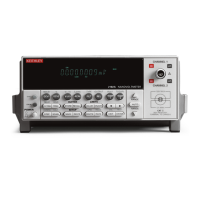I-10
Delta, Pulse Delta, and Differential Conductance
Pulse Delta calculation example
3-point measur
ement technique – Assume you want to measure the voltage across a low
power 1Ω DUT
. The Pulse Delta process will reduce DUT heating and eliminate the
effects of thermal EMFs.
Assume the Model 6221 is configured to output +10mA and 0mA pulses. Due to a 10µV
thermal EMF in the test leads, the following Model 2182A measurement conversions
(A/Ds) are made for the first Pulse Delta cycle.
A/D A = 0.01mV
A/D B = 10.01mV
A/D C = 0.01mV
The first Pulse Delta reading (using the 3-point measurement technique) is calculated as
follows:
The above 3-point measurement technique effectively eliminated the 10µV thermal EMF
from the Pulse Delta reading.
2-point measurement technique – Assume for the above example that DUT heating
causes the A/D measurement at point C to be 1.01mV. Using the 3-point measurement
technique, Pulse Delta (by calculation) would instead be 9.5mV. This results in 5% mea-
surement error due to heating.
The affects of heating can be eliminated by not performing the measurement at point C
(low pulse). For this 2-point measurement technique, Pulse Delta is calculated as follows:
PulseDelta
2BA– C–
2
--------------------------
1–()
0
•=
2 10.01()0.01()– 0.01()–
2
----------------------------------------------------------------=
20mV
2
--------------=
10mV=
PulseDelta
2B 2A–
2
--------------------
1–()
0
•=
2 10.01()2 0.01()–
2
----------------------------------------------=
20mV
2
--------------=
10mV=

